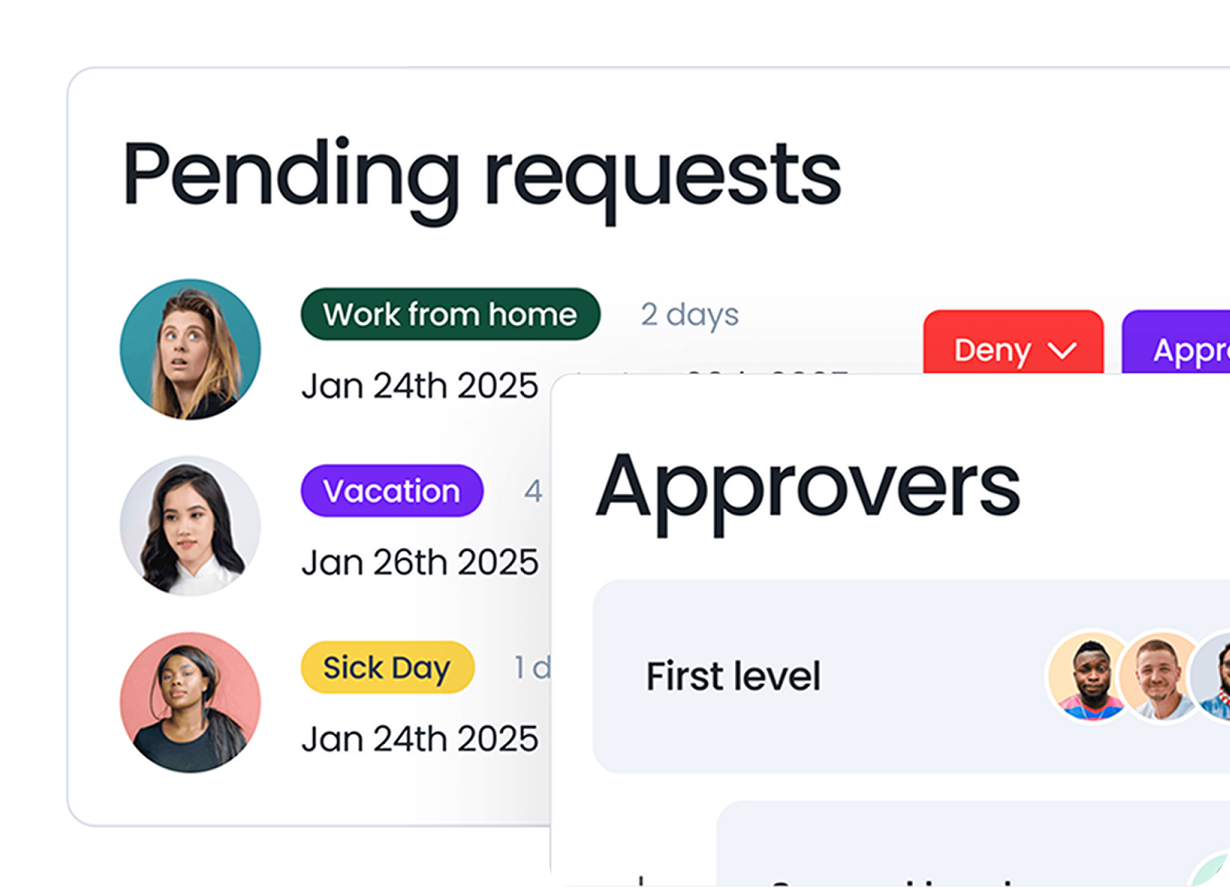Last updated on May 7, 2025
“Back in my day, everyone would go to the office, in person, at the same time!”
That’s probably what you’ll be saying when you tell your kids or grandkids about life before flexible schedules. Times have changed, and so have work environments.
Back in January 2023, nearly 50% of US companies had employees working full-time in the office. Today, 67% of employees have flexible schedules (FlexIndex).
Flexible work setups aren’t just a trend—they’re transforming workplaces for the better.
Research shows that employees with location flexibility experience less burnout, greater innovation, and a more positive outlook on company culture.
Is it time for your company to adopt this way of working? Keep reading, and we’ll guide you through the pros and cons, helping you build an effective flexible scheduling policy.
What is a Flexible Schedule?
A flexible schedule allows employees to work when it suits them best, ditching the rigid 9-to-5 framework. Employees are given the freedom to work at any time of day or any day of the week as long as they meet their deliverables.
5 Types of Flexible Work Schedules
Here’s a breakdown of the most popular types of flexible work schedules that cater to various employee needs:
Remote Work
In the post-covid world, remote work is something everyone is very familiar with.
This policy allows employees to work outside of the office, either from home, their favorite coffee shop, or sometimes a beach-front café in a foreign country––aka the good life. 🏖️
Allowing employees to work from anywhere means you can hire from anywhere! This opens up the job pool to global employees, allowing you to find top-tier candidates from all over the globe.
However, managing a remote team requires strategic planning for smooth collaboration across different time zones. Reliable HR tools can support compliance and team management.
Compressed Workweeks
Compressed workweeks provide employees the freedom to work longer days in order to enjoy shorter weeks.
For instance, they can decide to work 2 hours more per day from Monday to Thursday to have Friday off! Hello, three-day weekends 🥂
Another option would be to do a 9-day/2-week plan, which compresses two weeks or ten days of work into nine, giving employees two extra days off per month.
This setup can save time and boost morale. If you have a team that works in-office, this also helps cut down the time and stress of commuting.
Flextime
Flextime policies allow employees to work whenever they like, as long as they meet their quota of hours for the week or their deliverables. While there might be core hours when everyone is expected to be online or at their desk, there is no expected start and end time; employees can work when they like.
Part-Time
Part-time employees work less hours than full-timers, so they have plenty of wiggle room in their weeks. Certain part-timers have a very fixed schedule, but others enjoy the freedom of choosing the days and hours they’d like to work! This option is perfect for those balancing other commitments, like family or education.
Staggered Hours
Staggered hours provide employees freedom concerning their start and end times. This means that the early birds can start at 7 AM and the night owls at 10 AM, for example. This allows employees to alter their schedule based on the rest of their day, like their children's school or daycare schedules. It also means that the office is not always completely busy, offering your employees some quiet, focus time for heightened productivity and less water-cooler gossip.
Pros and Cons of Flexible Scheduling
👍 Pros of Flexible Scheduling
Improved work-life balance: There are only so many hours in a day, and it sometimes feels impossible to get it all done. Flexible schedules empower employees to build work schedules that work for them. This allows them to be there for their loved ones, take care of themselves, and have a little fun. As long as all their work gets done on time, it doesn’t matter when they do it.
Increase job satisfaction: It’s quite simple; happy people make happy employees! When your team feels trusted and empowered to make their own schedule and are able to make time for the things in their lives that matter, they tend to experience less stress, burnout, and job dissatisfaction.
Attracting top talent: A study by ManpowerGroup revealed that 38% of the global workforce places schedule flexibility as a top motivator when making career decisions. Flexible schedules help your company stand out amongst the competition, helping to attract and retain excellent employees. Furthermore, adopting a remote way of working opens up your talent pool. Rather than being restricted to a certain city or country, you can recruit top talent from all over the world!
Reducing absenteeism: Since employees can prioritize their personal lives without neglecting their professional responsibilities, employees are less likely to need days off. Rather than booking the morning off for a doctor's appointment, they’ll be able to work a few hours later with no loss in productivity and without using up valuable PTO time.
Increased productivity: A 2023 report indicated that employees with schedule flexibility are 39% more productive and 64% more focused. Allowing employees to work when they feel the most capable allows them to do their best work—on their own time. For example, night owls might not be super productive at 8 AM, but they might be a machine at midnight!
👎 Cons of Flexible Scheduling
Challenges in collaboration: When everyone's schedule is the same, it’s easy to find time to work together. But, when employees are spaced out across different time zones and with varying work hours, it can be a little harder to collaborate. Some employers combat this by establishing times when everyone should be working, called core working hours. Others set up recurring meetings to ensure employees carve out time to sync.
Difficulty in monitoring performance: It’s easy to measure who’s a hard worker with a stable schedule or an in-office team. Who’s there first in the morning? Who’s making suggestions and gathering teams together? In a flexible work setting, performance measurement needs to be done a little differently. Adapt KPIs to focus on outcomes, define goals, and monitor who is meeting or exceeding these expectations.
Potential for misuse: Flexible scheduling leaves no room for micromanagement. It’s heavily based on trust, and there’s no quick and easy way to ensure employees are not abusing the freedom offered. It’s recommended that managers make sure their team meets deadlines and deliverables, as well as continuously monitor productivity to find areas where they could optimize.
Balancing business needs: At the end of the day, a business needs to focus on its bottom line. HRs want to keep employees happy and healthy, but this cannot negatively impact the business’ success. It’s important to monitor KPIs, not only about employee satisfaction but also about the company’s revenue and growth, to keep both on track.
Tips for Implementing Flexible Work Schedules in Your Business
Here are some essential leave management tips to consider when implementing flexible scheduling:
Develop a flexible work policy
The first step to implementing flexible scheduling is to define what that means for your company. Will it be remote work, flextime, or a compressed workweek? As an HR manager, you need to decide which would benefit your employees and the business. It’s best practice to involve your team in the decision to make sure it resonates with their needs.
Once you’ve decided on the style of flexible work policy to implement, you’ll need to put it in writing! Describe the new regulations to make it clear to employees what freedoms and benefits they’re entitled to, what the expectations are, and how performance will be managed going forward. Outline all the ways this new policy will impact the workforce and how you plan to address any potential issues.
Use the right tools for tracking leave
Going from a set schedule to flexible hours will change the way your company is organized. You’ll need to implement some new methods of tracking employee leave now that your team’s schedule has so much variability.
Using a leave management system like Vacation Tracker provides visibility into your team’s whereabouts. With one look at the dashboard, you can know who’s working from home, who’s on vacation, and who’s sick.
![]()
Designed to accommodate both local and global teams, admins have the option to set up multiple locations within Vacation Tracker and customize policies based on each location’s leave laws. This makes compliance super easy and keeping track of your team a breeze!
![]()
Learn how to manage time off without
Tracking Can Be
confusion, delays, or admin headaches. 
Focus on results, not hours
Employers often get hyper-focused on making sure their team is putting in 40 hours per week when, instead, the focus should shift to outcomes. It’s not possible to track exactly how much time each employee works each week, but if they’re delivering their work, meeting deadlines, and showing up to meetings, it doesn’t matter! The goal is to create an engaged and productive team that helps your business thrive.
Set core work hours
It’s sometimes hard to ensure you’re getting the most out of your team if they’re not bouncing ideas off of each other and giving feedback. Cultivating team culture and collaboration is sometimes easier when everyone has designated overlapping hours. By setting core work hours, you create a window where team members are available to connect, brainstorm, and collaborate in real time. This way, even with flexible schedules, you can maintain a sense of unity and ensure productive interactions that help drive projects forward.
How to Make Flexible Scheduling Work for Your Business and Employees
Flexible scheduling is a great way to boost employee satisfaction while also improving productivity! With the right policies, tools, and focus, you can create a flexible work environment that keeps both employees and businesses thriving.
Ready to streamline your team’s flexible scheduling?
Vacation Tracker makes it easy to track leave and manage schedules seamlessly, whether you’re working locally or globally. See how Vacation Tracker can empower your team with visibility and flexibility—try it free today!

Claudia
Claudia is an experienced marketer with a passion for writing and creating engaging content that connects with readers.




